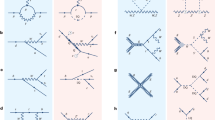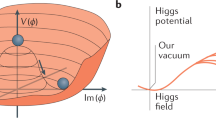Abstract
Powerful symmetry principles have guided physicists in their quest for nature's fundamental laws. The successful gauge theory of electroweak interactions postulates a more extensive symmetry for its equations than are manifest in the world. The discrepancy is ascribed to a pervasive symmetry-breaking field, which fills all space uniformly, rendering the Universe a sort of exotic superconductor. So far, the evidence for these bold ideas is indirect. But soon the theory will undergo a critical test depending on whether the quanta of this symmetry-breaking field, the so-called Higgs particles, are produced at the Large Hadron Collider (due to begin operation in 2007).
This is a preview of subscription content, access via your institution
Access options
Subscribe to this journal
Receive 51 print issues and online access
$199.00 per year
only $3.90 per issue
Buy this article
- Purchase on Springer Link
- Instant access to full article PDF
Prices may be subject to local taxes which are calculated during checkout





Similar content being viewed by others
References
Glashow, S. Partial symmetries of weak interactions. Nucl. Phys. 22, 579–588 (1961).
Weinberg, S. A model of leptons. Phys. Rev. Lett. 19, 1264–1266 (1967).
Salam, A. in Elementary Particle Physics, Nobel Symp. (ed. Svarthom, N.) No. 8, 367–377 (Almqvist & Wiksell, Stokholm, 1968).
't Hooft, G. & Veltman, M. Regularization and renormalization of gauge fields. Nucl. Phys. B 44, 189–213 (1972).
Englert, F. & Brout, R. Broken symmetry and the mass of gauge vector mesons. Phys. Rev. Lett. 13, 321–323 (1964).
Higgs, P. Broken symmetries and the masses of gauge bosons Phys. Rev. Lett. 13, 508–509 (1964).
Wess, J. & Zumino, B. A lagrangian model invariant under supergauge transformations. Phys. Lett. B 49, 52–54 (1974).
Ferrara, S. (ed.) Supersymmetry (North Holland/World Scientific, Singapore, 1987).
Weinberg, S. The Quantum Theory of Fields 1: Foundations (Cambridge Univ. Press, Cambridge, 1995).
Wilczek, F. Quantum field theory. Rev. Mod. Phys. 71, S85–S95 (1999).
Weyl, H. Z. Elektron and gravitation I. Z. Phys. 56, 330–352 (1929).
London, F. Quantenmechanische deutung der theorie von Weyl. Z. Phys. 42, 375–389 (1927).
Yang, C. N. & Mills, R. Conservation of isotopic spin and isotopic gauge invariance. Phys. Rev. 96, 191–195 (1954).
ALEPH Collaboration, DELPHI Collaboration, L3 Collaboration, OPAL Collaboration & The LEP Working Group for Higgs Boson. Search for the standard model Higgs boson at LEP. Phys. Lett. B 565, 61–75 (2003).
LEP Electroweak Working Group [online] 〈http://lepewwg.web.cern.ch/LEPEWWG〉 (2004).
Einhorn, M. (ed) The Standard Model Higgs Boson (North Holland, Amsterdam, 1991).
Gunion, J., Haber, H., Kane, G., & Dawson, S. The Higgs Hunter's Guide (Addison Wesley, New York, 1990).
Gross, D. & Wilczek, F. Ultraviolet behavior of non-Abelian gauge theories. Phys. Rev. Lett. 30, 1343–1346 (1973).
Politzer, H. Reliable perturbative results for strong interactions? Phys. Rev. Lett. 30, 1346–1349 (1973).
Riess, A. et al., Observational evidence from supernovae for an accelerating universe and a cosmological constant. Astron. J. 116, 1009–1038 (1998).
Permutter, S. et al. Measurements of Ω and Λ from 42 high-redshift supernovae. Astrophys. J. 517, 565–586 (1999).
Spergel, D. et al., Determination of cosmological parameters. Astrophys. J. 148 (suppl.), 175–194 (2003).
London, F. Superfluids 1: Macroscopic Theory of Superconductivity (Wiley, New York, 1950).
Bardeen, J., Cooper, L. & Schrieffer, R. Theory of superconductivity. Phys. Rev. 108, 1175–1204 (1957).
Weinberg, S. Quantum Theory of Fields, Vol. 3: Supersymmetry (Cambridge Univ. Press, Cambridge 2000).
Lee, T. D. & Yang, C. N. Question of parity conservation in weak interactions. Phys. Rev. 104, 254–258 (1956).
Lederman, L. & Teresi, D. The God Particle (Bantam, New York, 1993).
Wilczek, F. The origin of mass. Ann. Phys. (MIT) 16, 24–35 (2003).
Einstein, A. Does the inertia of a body depend upon its energy content? [in German] Ann. Phys. 18, 639–641 (1905).
Kuti, J., Lin, L. & Shen, Y. Upper bound on the Higgs-boson mass in the standard model Phys. Rev. Lett. 61, 678–681 (1988).
Wilczek, F. Decays of heavy vector mesons into Higgs particles. Phys. Rev. Lett. 39, 1304–1306 (1977).
Bjorken, J. in Proc. SLAC Summer School (SLAC publication 198, 1976).
Georgi, H., Glashow, S., Machacek, M. & Nanopoulos, D. Higgs bosons from two-gluon annihilation in proton–proton collisions. Phys. Rev. Lett. 40, 692–694 (1978).
CMS collaboration. The compact muon solenoid [online] 〈http://www.lip.pt/~outreach/docs/cms2〉 (2004).
Pati, & Salam, A. Unified lepton-hadron symmetry and a gauge theory of the basic interactions. Phys. Rev. D 8, 1240–1251 (1973).
Georgi, H., Quinn, H. & Weinberg, S. Hierarchy of interactions in unified gauge theories. Phys. Rev. Lett. 33, 451–454 (1974).
Dimopoulos, S., Raby, S. & Wilczek, F. Supersymmetry and the scale of unification. Phys. Rev. D 24, 1681–1683 (1981).
Dimopoulos, S. & Georgi, H. Softly broken supersymmetry and SU(5). Nucl. Phys. 193, 150–162 (1981).
Amaldi, U., de Boer, W. & Fürstenau, H. Comparison of grand unified theories with electroweak and strong coupling constants measured at LEP. Phys. Lett. B 260, 447–455 (1991).
Ellis, J., Kelly, S. & Nanopoulos, D. Precision LEP data, supersymmetric GUTs and string unification. Phys. Lett. B 249, 441–448 (1990).
Gildener, E. & Weinberg, S. Symmetry breaking and scalar bosons. Phys. Rev. D 13, 3333–3341 (1976).
Witten, E. Dynamical breaking of supersymmetry. Nucl. Phys. B 188, 513–554 (1981).
Gell-Mann, M., Ramond, P. & Slansky, R. in Supergravity: Proceedings of the Supergravity Workshop at Stony Brook, September 27–29, 1979 (eds van Nieuwenhuizen, P. & Freedman, D.) 315–321 (North Holland, Amsterdam, 1979).
Yanagida, T. in Workshop on Unified Theory and Baryon Number in the Universe (eds Sawada, O. & Sugamoto, A.) 95–98 (KEK, Tsukuba, 1979).
Wilczek, F. Scaling mount Planck 3: is that all there is? Phys. Today 55N8, 10–11 (2002).
Kirzhnits, D. & Linde, A. Symmetry behaviour in guage theories. Ann. Phys. 101, 195–238 (1976).
Guth, A. Inflationary universe: a possible solution to the horizon and flatness problems. Phys. Rev. D 23, 347–356 (1981).
A precision measurement of the mass of the top quark. Nature 429, 638–642 (2004).
Georgi, H. & Glashow, S. Unity of all elementary-particle forces. Phys. Rev. Lett. 32, 438–441 (1974).
Georgi, H. in Particles and Fields 1974 (ed. Carlson, C.) 575–584 (AIP, New York, 1975).
Author information
Authors and Affiliations
Ethics declarations
Competing interests
The author declares no competing financial interests.
Rights and permissions
About this article
Cite this article
Wilczek, F. In search of symmetry lost. Nature 433, 239–247 (2005). https://doi.org/10.1038/nature03281
Published:
Issue Date:
DOI: https://doi.org/10.1038/nature03281
This article is cited by
-
Fundamental Physics
Foundations of Physics (2007)
-
Epistemological and Historical Implications for Elementary Particle Theories
International Journal of Theoretical Physics (2007)
Comments
By submitting a comment you agree to abide by our Terms and Community Guidelines. If you find something abusive or that does not comply with our terms or guidelines please flag it as inappropriate.



